Report: Selecting an ERP and Vendor for CRLS - University
VerifiedAdded on 2020/04/07
|9
|1556
|42
Report
AI Summary
This report, prepared for CRLS, explores the critical process of selecting an Enterprise Resource Planning (ERP) system and vendor. It begins by outlining the essential steps in ERP selection, including assessing training needs, vendor performance, and scalability, alongside confirming ERP requirements to match vendors and products. The report then delves into the specific business requirements of CRLS, emphasizing the need for ERP to integrate processes, enhance efficiency, and manage the company's growth, including expansion to multiple cities and an increase in employees. Challenges such as manual process integration and the importance of scalability are addressed. The report evaluates potential ERP systems and vendors, including Epicor, IFS, Infor, Sage, Microsoft, Oracle JD Edwards, SAP, and Odoo, highlighting their features and suitability. It also identifies key ERP modules like CRM, HR, finance, and purchasing systems, and discusses the advantages of cloud-based ERP systems over on-premise solutions. The report concludes by emphasizing the importance of staff training and vendor financial stability for successful ERP implementation. This report is a valuable resource for students studying business development on Desklib, providing insights into real-world business challenges and solutions.
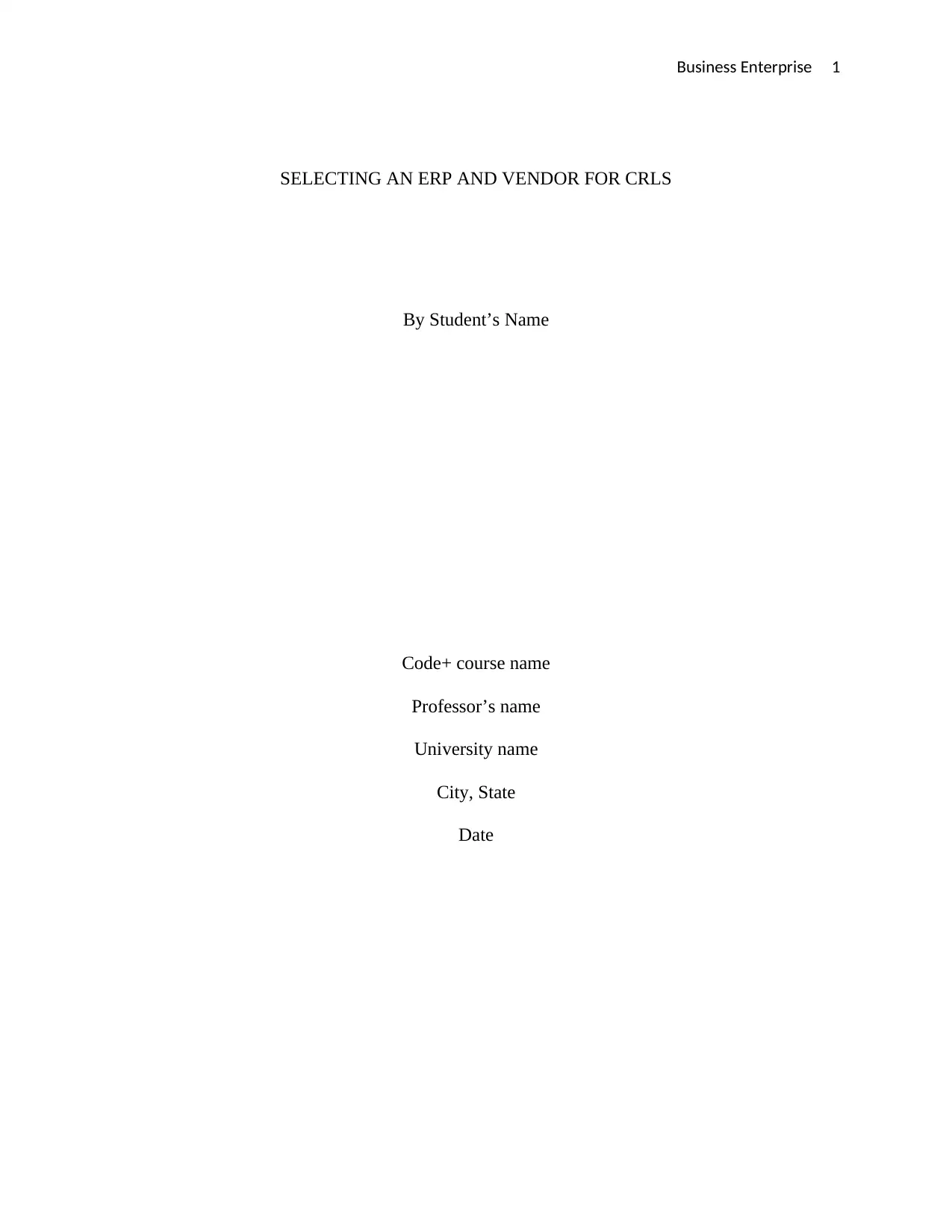
Business Enterprise 1
SELECTING AN ERP AND VENDOR FOR CRLS
By Student’s Name
Code+ course name
Professor’s name
University name
City, State
Date
SELECTING AN ERP AND VENDOR FOR CRLS
By Student’s Name
Code+ course name
Professor’s name
University name
City, State
Date
Paraphrase This Document
Need a fresh take? Get an instant paraphrase of this document with our AI Paraphraser
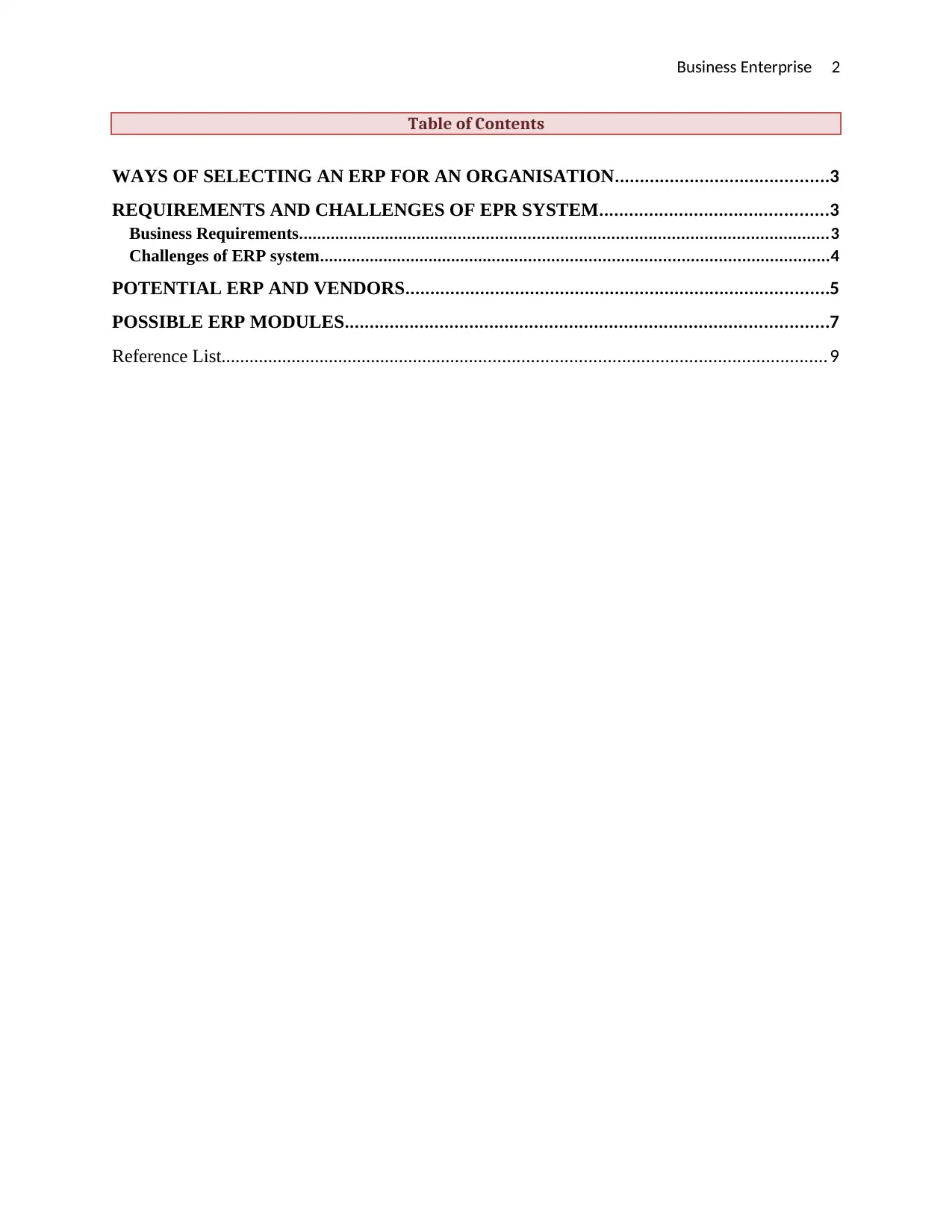
Business Enterprise 2
Table of Contents
WAYS OF SELECTING AN ERP FOR AN ORGANISATION...........................................3
REQUIREMENTS AND CHALLENGES OF EPR SYSTEM..............................................3
Business Requirements...................................................................................................................3
Challenges of ERP system...............................................................................................................4
POTENTIAL ERP AND VENDORS.....................................................................................5
POSSIBLE ERP MODULES.................................................................................................7
Reference List................................................................................................................................9
Table of Contents
WAYS OF SELECTING AN ERP FOR AN ORGANISATION...........................................3
REQUIREMENTS AND CHALLENGES OF EPR SYSTEM..............................................3
Business Requirements...................................................................................................................3
Challenges of ERP system...............................................................................................................4
POTENTIAL ERP AND VENDORS.....................................................................................5
POSSIBLE ERP MODULES.................................................................................................7
Reference List................................................................................................................................9
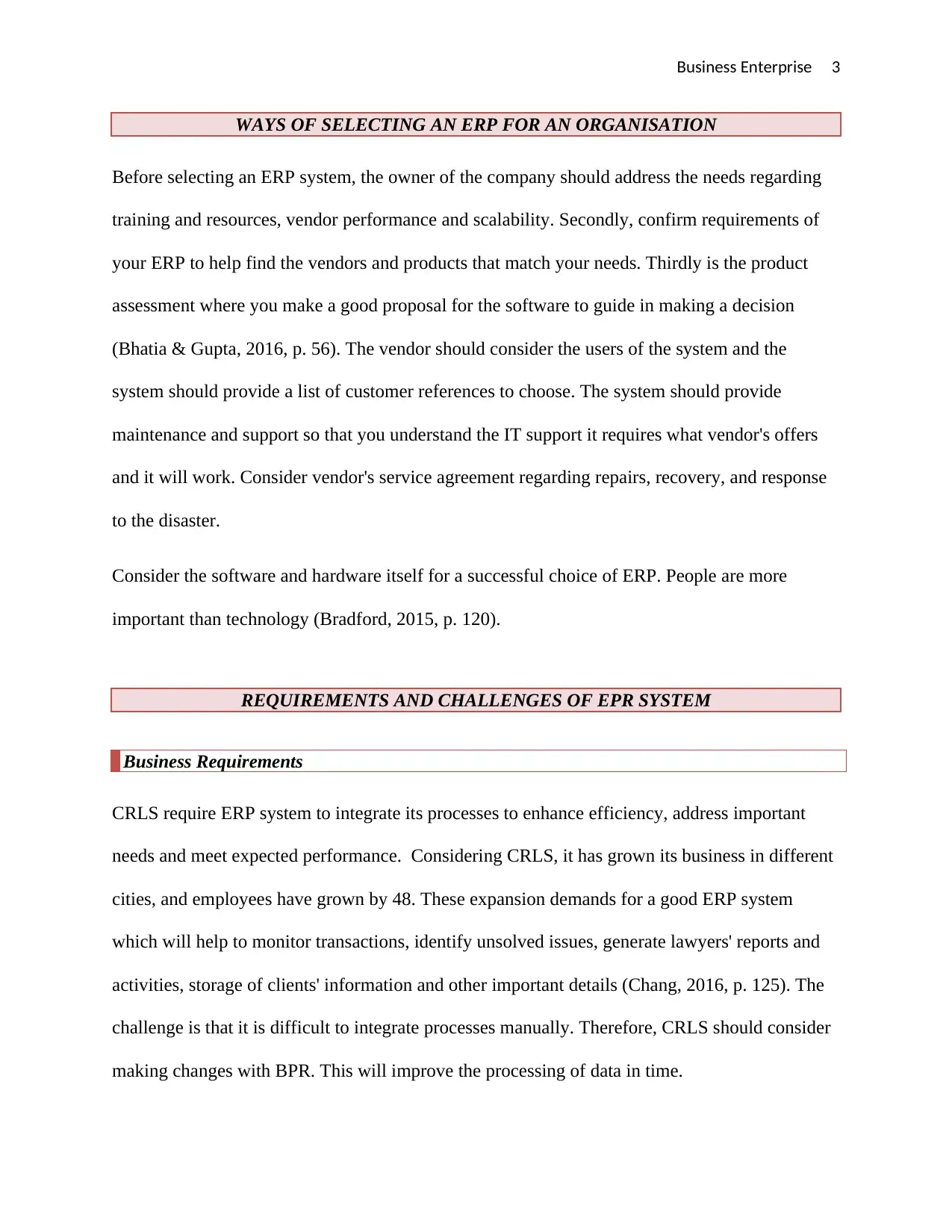
Business Enterprise 3
WAYS OF SELECTING AN ERP FOR AN ORGANISATION
Before selecting an ERP system, the owner of the company should address the needs regarding
training and resources, vendor performance and scalability. Secondly, confirm requirements of
your ERP to help find the vendors and products that match your needs. Thirdly is the product
assessment where you make a good proposal for the software to guide in making a decision
(Bhatia & Gupta, 2016, p. 56). The vendor should consider the users of the system and the
system should provide a list of customer references to choose. The system should provide
maintenance and support so that you understand the IT support it requires what vendor's offers
and it will work. Consider vendor's service agreement regarding repairs, recovery, and response
to the disaster.
Consider the software and hardware itself for a successful choice of ERP. People are more
important than technology (Bradford, 2015, p. 120).
REQUIREMENTS AND CHALLENGES OF EPR SYSTEM
Business Requirements
CRLS require ERP system to integrate its processes to enhance efficiency, address important
needs and meet expected performance. Considering CRLS, it has grown its business in different
cities, and employees have grown by 48. These expansion demands for a good ERP system
which will help to monitor transactions, identify unsolved issues, generate lawyers' reports and
activities, storage of clients' information and other important details (Chang, 2016, p. 125). The
challenge is that it is difficult to integrate processes manually. Therefore, CRLS should consider
making changes with BPR. This will improve the processing of data in time.
WAYS OF SELECTING AN ERP FOR AN ORGANISATION
Before selecting an ERP system, the owner of the company should address the needs regarding
training and resources, vendor performance and scalability. Secondly, confirm requirements of
your ERP to help find the vendors and products that match your needs. Thirdly is the product
assessment where you make a good proposal for the software to guide in making a decision
(Bhatia & Gupta, 2016, p. 56). The vendor should consider the users of the system and the
system should provide a list of customer references to choose. The system should provide
maintenance and support so that you understand the IT support it requires what vendor's offers
and it will work. Consider vendor's service agreement regarding repairs, recovery, and response
to the disaster.
Consider the software and hardware itself for a successful choice of ERP. People are more
important than technology (Bradford, 2015, p. 120).
REQUIREMENTS AND CHALLENGES OF EPR SYSTEM
Business Requirements
CRLS require ERP system to integrate its processes to enhance efficiency, address important
needs and meet expected performance. Considering CRLS, it has grown its business in different
cities, and employees have grown by 48. These expansion demands for a good ERP system
which will help to monitor transactions, identify unsolved issues, generate lawyers' reports and
activities, storage of clients' information and other important details (Chang, 2016, p. 125). The
challenge is that it is difficult to integrate processes manually. Therefore, CRLS should consider
making changes with BPR. This will improve the processing of data in time.
⊘ This is a preview!⊘
Do you want full access?
Subscribe today to unlock all pages.

Trusted by 1+ million students worldwide
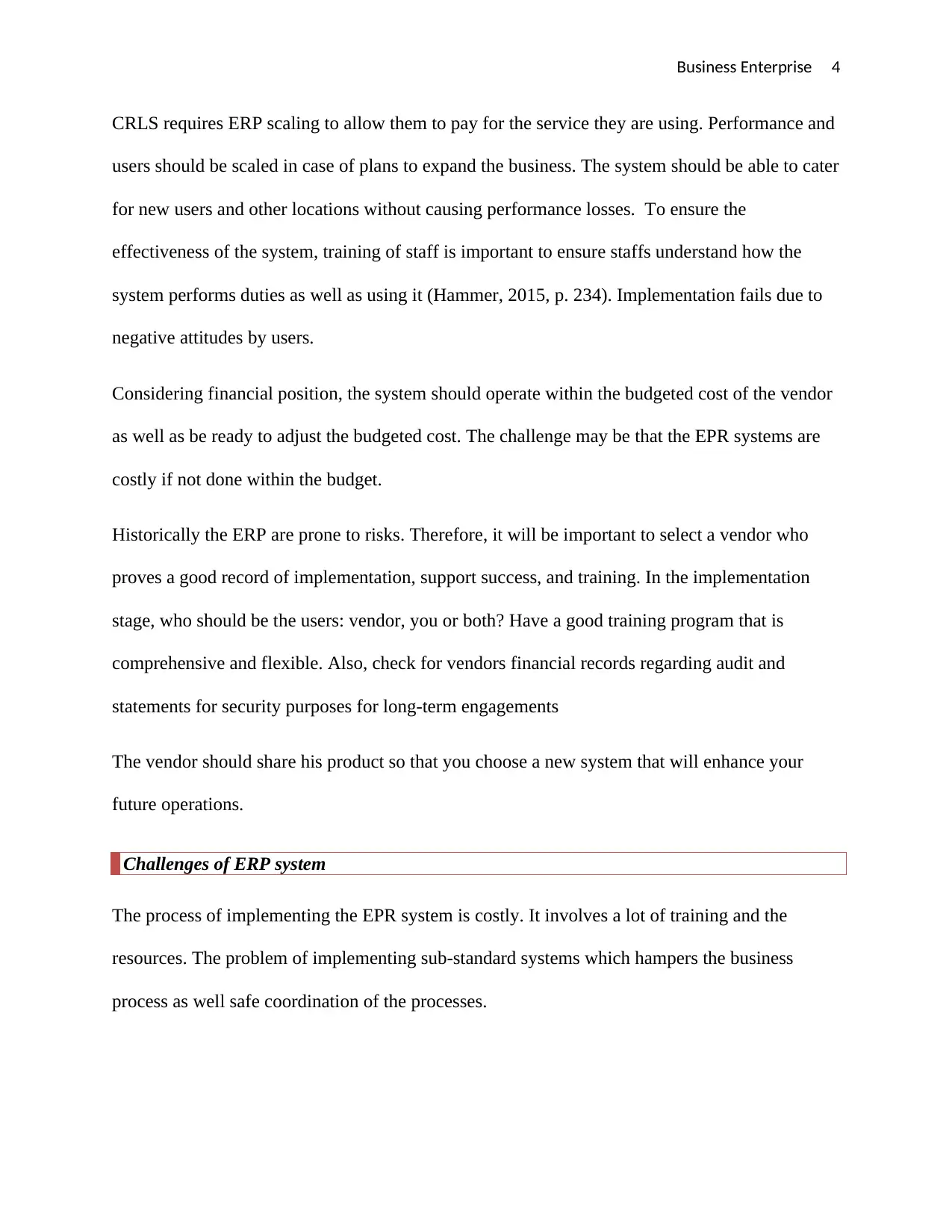
Business Enterprise 4
CRLS requires ERP scaling to allow them to pay for the service they are using. Performance and
users should be scaled in case of plans to expand the business. The system should be able to cater
for new users and other locations without causing performance losses. To ensure the
effectiveness of the system, training of staff is important to ensure staffs understand how the
system performs duties as well as using it (Hammer, 2015, p. 234). Implementation fails due to
negative attitudes by users.
Considering financial position, the system should operate within the budgeted cost of the vendor
as well as be ready to adjust the budgeted cost. The challenge may be that the EPR systems are
costly if not done within the budget.
Historically the ERP are prone to risks. Therefore, it will be important to select a vendor who
proves a good record of implementation, support success, and training. In the implementation
stage, who should be the users: vendor, you or both? Have a good training program that is
comprehensive and flexible. Also, check for vendors financial records regarding audit and
statements for security purposes for long-term engagements
The vendor should share his product so that you choose a new system that will enhance your
future operations.
Challenges of ERP system
The process of implementing the EPR system is costly. It involves a lot of training and the
resources. The problem of implementing sub-standard systems which hampers the business
process as well safe coordination of the processes.
CRLS requires ERP scaling to allow them to pay for the service they are using. Performance and
users should be scaled in case of plans to expand the business. The system should be able to cater
for new users and other locations without causing performance losses. To ensure the
effectiveness of the system, training of staff is important to ensure staffs understand how the
system performs duties as well as using it (Hammer, 2015, p. 234). Implementation fails due to
negative attitudes by users.
Considering financial position, the system should operate within the budgeted cost of the vendor
as well as be ready to adjust the budgeted cost. The challenge may be that the EPR systems are
costly if not done within the budget.
Historically the ERP are prone to risks. Therefore, it will be important to select a vendor who
proves a good record of implementation, support success, and training. In the implementation
stage, who should be the users: vendor, you or both? Have a good training program that is
comprehensive and flexible. Also, check for vendors financial records regarding audit and
statements for security purposes for long-term engagements
The vendor should share his product so that you choose a new system that will enhance your
future operations.
Challenges of ERP system
The process of implementing the EPR system is costly. It involves a lot of training and the
resources. The problem of implementing sub-standard systems which hampers the business
process as well safe coordination of the processes.
Paraphrase This Document
Need a fresh take? Get an instant paraphrase of this document with our AI Paraphraser
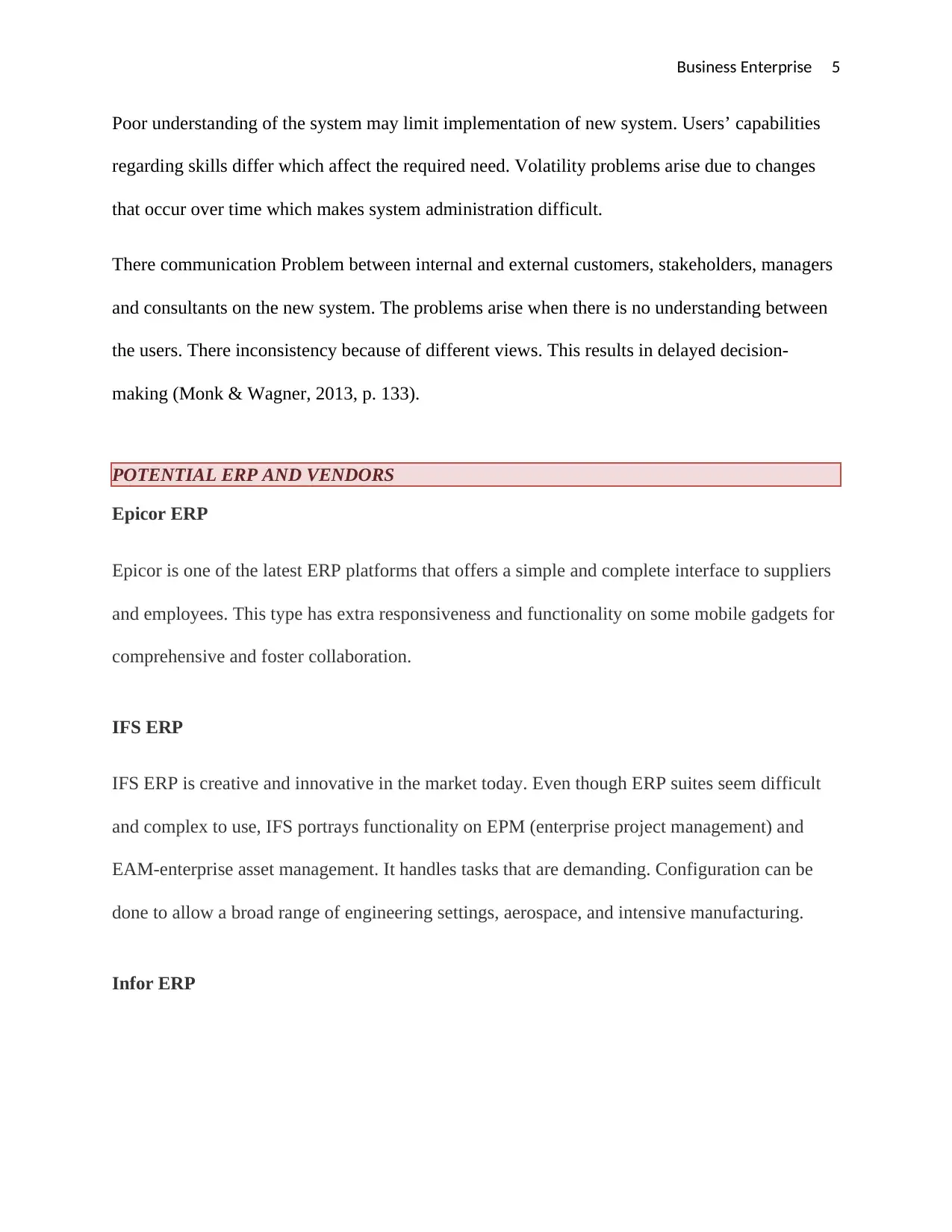
Business Enterprise 5
Poor understanding of the system may limit implementation of new system. Users’ capabilities
regarding skills differ which affect the required need. Volatility problems arise due to changes
that occur over time which makes system administration difficult.
There communication Problem between internal and external customers, stakeholders, managers
and consultants on the new system. The problems arise when there is no understanding between
the users. There inconsistency because of different views. This results in delayed decision-
making (Monk & Wagner, 2013, p. 133).
POTENTIAL ERP AND VENDORS
Epicor ERP
Epicor is one of the latest ERP platforms that offers a simple and complete interface to suppliers
and employees. This type has extra responsiveness and functionality on some mobile gadgets for
comprehensive and foster collaboration.
IFS ERP
IFS ERP is creative and innovative in the market today. Even though ERP suites seem difficult
and complex to use, IFS portrays functionality on EPM (enterprise project management) and
EAM-enterprise asset management. It handles tasks that are demanding. Configuration can be
done to allow a broad range of engineering settings, aerospace, and intensive manufacturing.
Infor ERP
Poor understanding of the system may limit implementation of new system. Users’ capabilities
regarding skills differ which affect the required need. Volatility problems arise due to changes
that occur over time which makes system administration difficult.
There communication Problem between internal and external customers, stakeholders, managers
and consultants on the new system. The problems arise when there is no understanding between
the users. There inconsistency because of different views. This results in delayed decision-
making (Monk & Wagner, 2013, p. 133).
POTENTIAL ERP AND VENDORS
Epicor ERP
Epicor is one of the latest ERP platforms that offers a simple and complete interface to suppliers
and employees. This type has extra responsiveness and functionality on some mobile gadgets for
comprehensive and foster collaboration.
IFS ERP
IFS ERP is creative and innovative in the market today. Even though ERP suites seem difficult
and complex to use, IFS portrays functionality on EPM (enterprise project management) and
EAM-enterprise asset management. It handles tasks that are demanding. Configuration can be
done to allow a broad range of engineering settings, aerospace, and intensive manufacturing.
Infor ERP
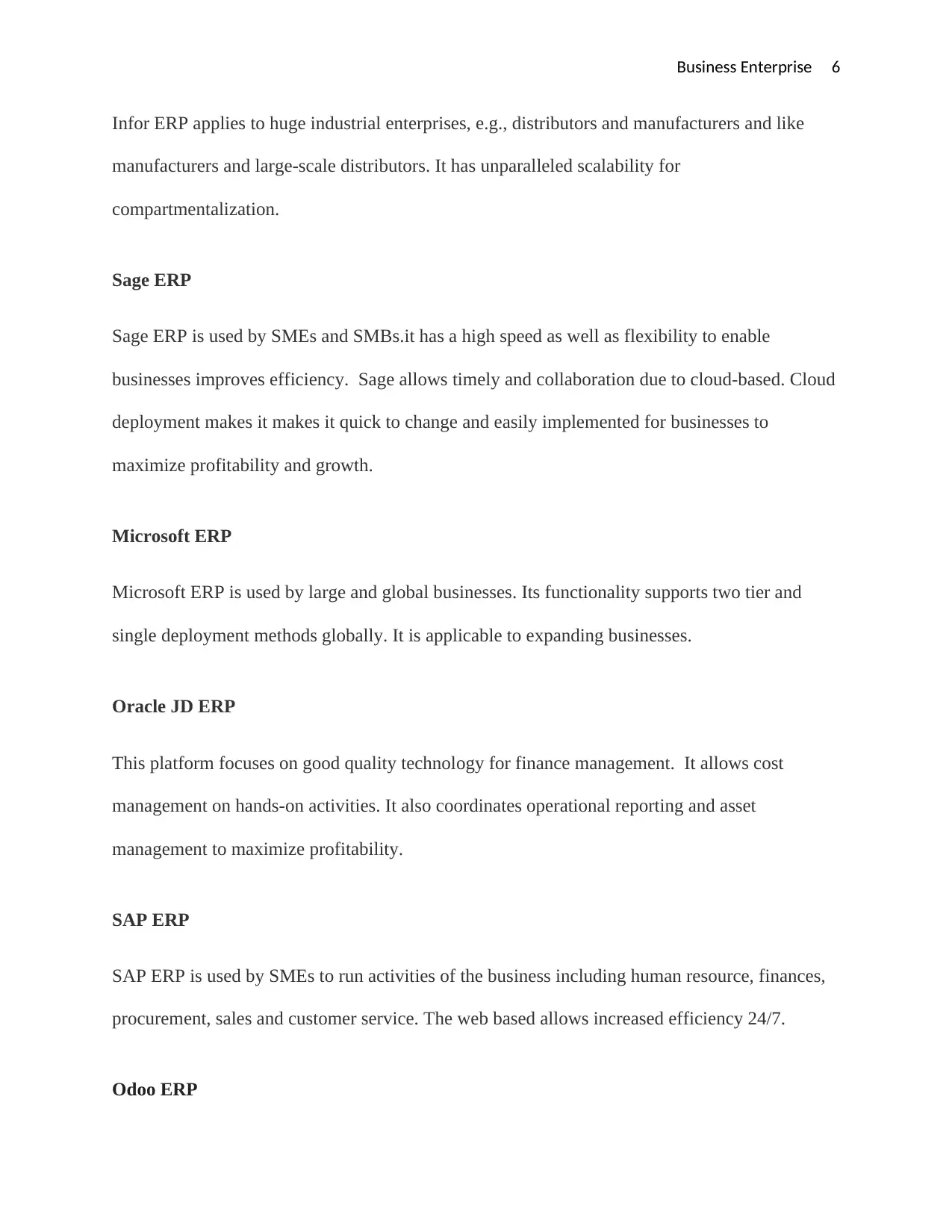
Business Enterprise 6
Infor ERP applies to huge industrial enterprises, e.g., distributors and manufacturers and like
manufacturers and large-scale distributors. It has unparalleled scalability for
compartmentalization.
Sage ERP
Sage ERP is used by SMEs and SMBs.it has a high speed as well as flexibility to enable
businesses improves efficiency. Sage allows timely and collaboration due to cloud-based. Cloud
deployment makes it makes it quick to change and easily implemented for businesses to
maximize profitability and growth.
Microsoft ERP
Microsoft ERP is used by large and global businesses. Its functionality supports two tier and
single deployment methods globally. It is applicable to expanding businesses.
Oracle JD ERP
This platform focuses on good quality technology for finance management. It allows cost
management on hands-on activities. It also coordinates operational reporting and asset
management to maximize profitability.
SAP ERP
SAP ERP is used by SMEs to run activities of the business including human resource, finances,
procurement, sales and customer service. The web based allows increased efficiency 24/7.
Odoo ERP
Infor ERP applies to huge industrial enterprises, e.g., distributors and manufacturers and like
manufacturers and large-scale distributors. It has unparalleled scalability for
compartmentalization.
Sage ERP
Sage ERP is used by SMEs and SMBs.it has a high speed as well as flexibility to enable
businesses improves efficiency. Sage allows timely and collaboration due to cloud-based. Cloud
deployment makes it makes it quick to change and easily implemented for businesses to
maximize profitability and growth.
Microsoft ERP
Microsoft ERP is used by large and global businesses. Its functionality supports two tier and
single deployment methods globally. It is applicable to expanding businesses.
Oracle JD ERP
This platform focuses on good quality technology for finance management. It allows cost
management on hands-on activities. It also coordinates operational reporting and asset
management to maximize profitability.
SAP ERP
SAP ERP is used by SMEs to run activities of the business including human resource, finances,
procurement, sales and customer service. The web based allows increased efficiency 24/7.
Odoo ERP
⊘ This is a preview!⊘
Do you want full access?
Subscribe today to unlock all pages.

Trusted by 1+ million students worldwide
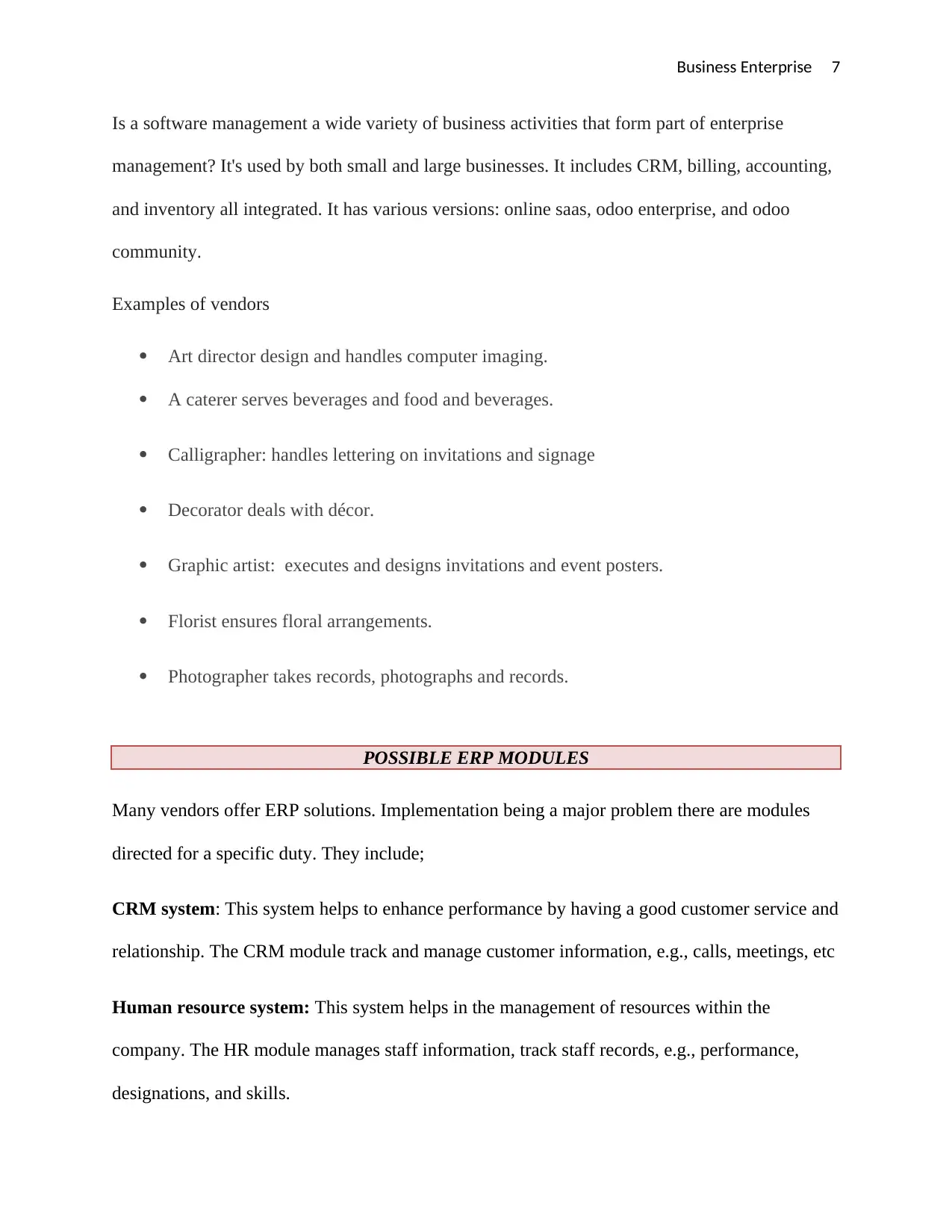
Business Enterprise 7
Is a software management a wide variety of business activities that form part of enterprise
management? It's used by both small and large businesses. It includes CRM, billing, accounting,
and inventory all integrated. It has various versions: online saas, odoo enterprise, and odoo
community.
Examples of vendors
Art director design and handles computer imaging.
A caterer serves beverages and food and beverages.
Calligrapher: handles lettering on invitations and signage
Decorator deals with décor.
Graphic artist: executes and designs invitations and event posters.
Florist ensures floral arrangements.
Photographer takes records, photographs and records.
POSSIBLE ERP MODULES
Many vendors offer ERP solutions. Implementation being a major problem there are modules
directed for a specific duty. They include;
CRM system: This system helps to enhance performance by having a good customer service and
relationship. The CRM module track and manage customer information, e.g., calls, meetings, etc
Human resource system: This system helps in the management of resources within the
company. The HR module manages staff information, track staff records, e.g., performance,
designations, and skills.
Is a software management a wide variety of business activities that form part of enterprise
management? It's used by both small and large businesses. It includes CRM, billing, accounting,
and inventory all integrated. It has various versions: online saas, odoo enterprise, and odoo
community.
Examples of vendors
Art director design and handles computer imaging.
A caterer serves beverages and food and beverages.
Calligrapher: handles lettering on invitations and signage
Decorator deals with décor.
Graphic artist: executes and designs invitations and event posters.
Florist ensures floral arrangements.
Photographer takes records, photographs and records.
POSSIBLE ERP MODULES
Many vendors offer ERP solutions. Implementation being a major problem there are modules
directed for a specific duty. They include;
CRM system: This system helps to enhance performance by having a good customer service and
relationship. The CRM module track and manage customer information, e.g., calls, meetings, etc
Human resource system: This system helps in the management of resources within the
company. The HR module manages staff information, track staff records, e.g., performance,
designations, and skills.
Paraphrase This Document
Need a fresh take? Get an instant paraphrase of this document with our AI Paraphraser
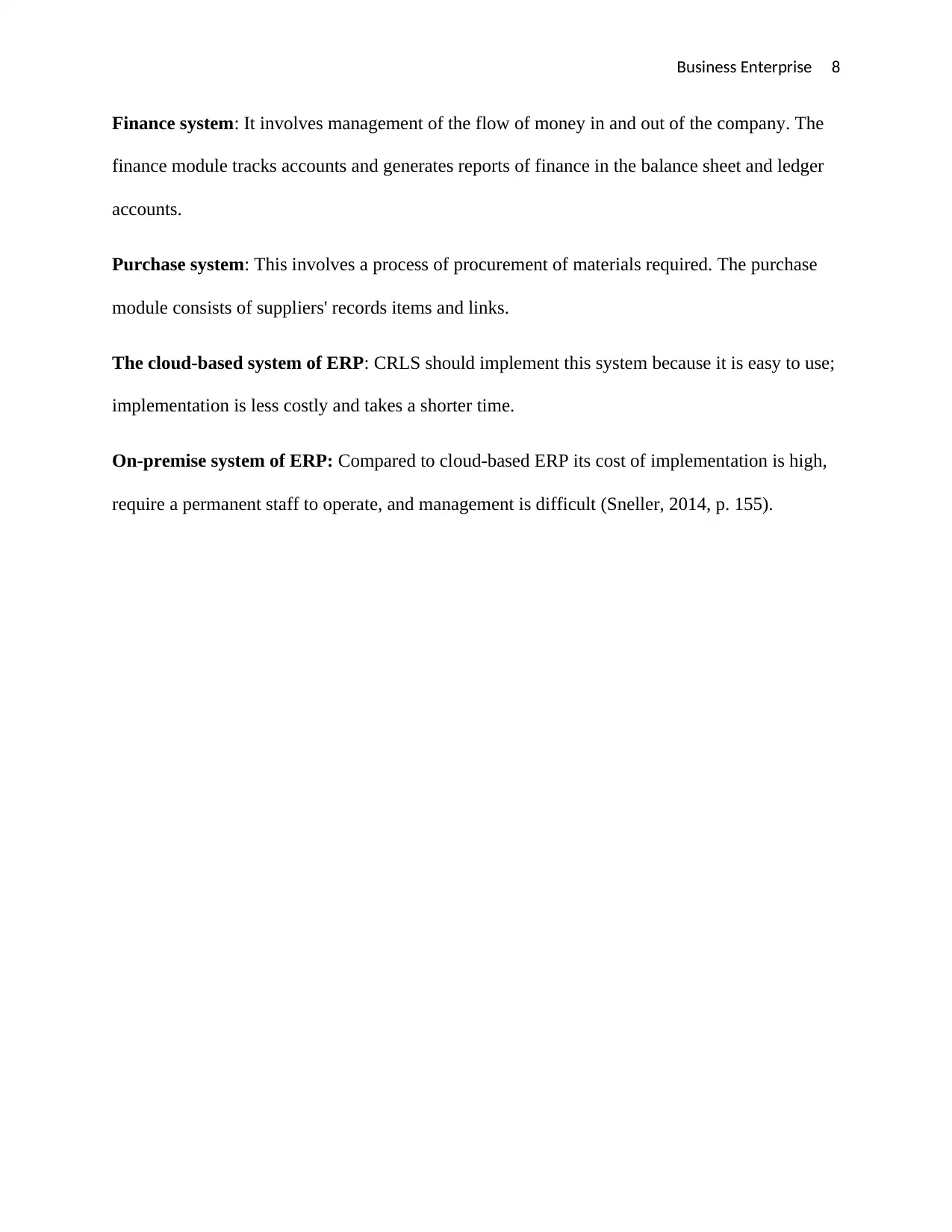
Business Enterprise 8
Finance system: It involves management of the flow of money in and out of the company. The
finance module tracks accounts and generates reports of finance in the balance sheet and ledger
accounts.
Purchase system: This involves a process of procurement of materials required. The purchase
module consists of suppliers' records items and links.
The cloud-based system of ERP: CRLS should implement this system because it is easy to use;
implementation is less costly and takes a shorter time.
On-premise system of ERP: Compared to cloud-based ERP its cost of implementation is high,
require a permanent staff to operate, and management is difficult (Sneller, 2014, p. 155).
Finance system: It involves management of the flow of money in and out of the company. The
finance module tracks accounts and generates reports of finance in the balance sheet and ledger
accounts.
Purchase system: This involves a process of procurement of materials required. The purchase
module consists of suppliers' records items and links.
The cloud-based system of ERP: CRLS should implement this system because it is easy to use;
implementation is less costly and takes a shorter time.
On-premise system of ERP: Compared to cloud-based ERP its cost of implementation is high,
require a permanent staff to operate, and management is difficult (Sneller, 2014, p. 155).
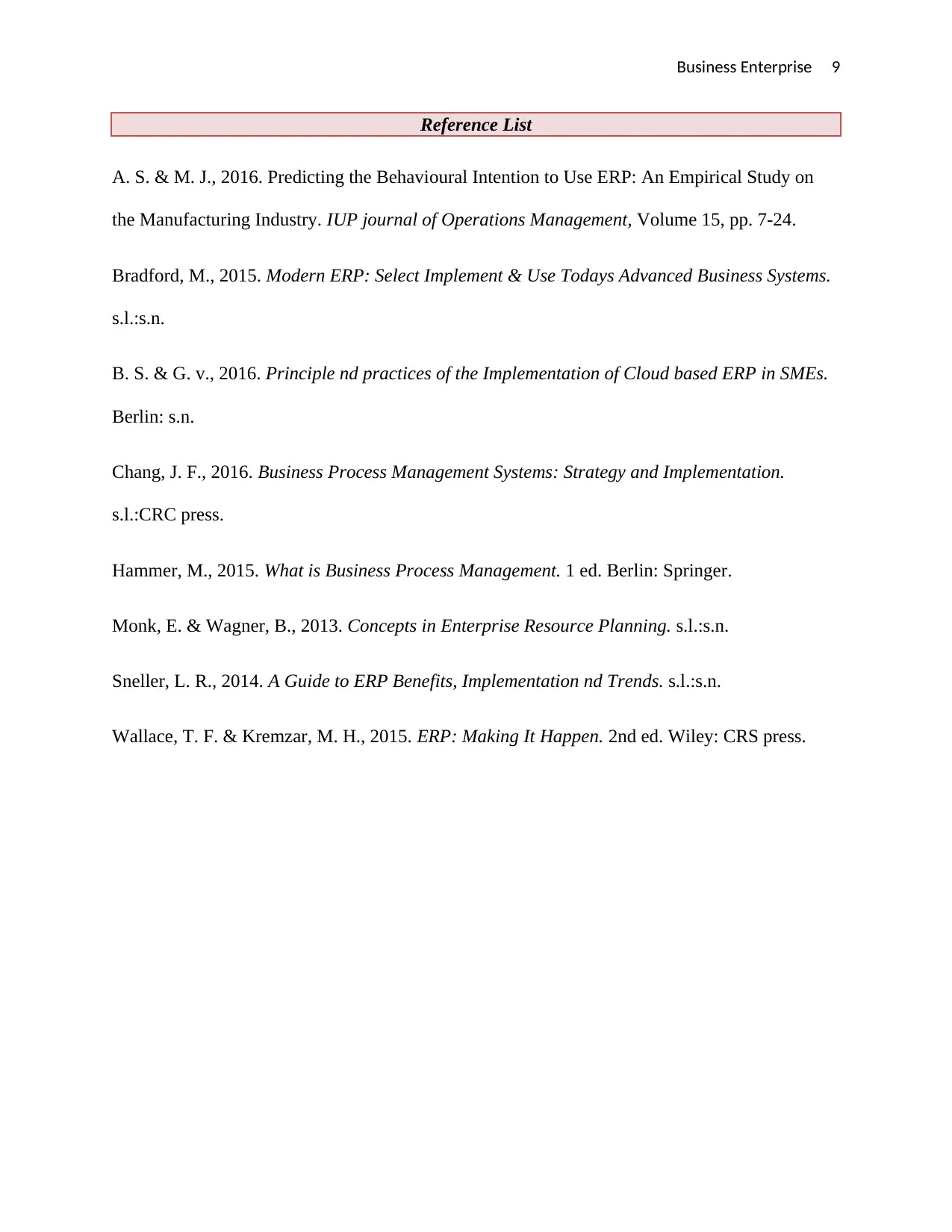
Business Enterprise 9
Reference List
A. S. & M. J., 2016. Predicting the Behavioural Intention to Use ERP: An Empirical Study on
the Manufacturing Industry. IUP journal of Operations Management, Volume 15, pp. 7-24.
Bradford, M., 2015. Modern ERP: Select Implement & Use Todays Advanced Business Systems.
s.l.:s.n.
B. S. & G. v., 2016. Principle nd practices of the Implementation of Cloud based ERP in SMEs.
Berlin: s.n.
Chang, J. F., 2016. Business Process Management Systems: Strategy and Implementation.
s.l.:CRC press.
Hammer, M., 2015. What is Business Process Management. 1 ed. Berlin: Springer.
Monk, E. & Wagner, B., 2013. Concepts in Enterprise Resource Planning. s.l.:s.n.
Sneller, L. R., 2014. A Guide to ERP Benefits, Implementation nd Trends. s.l.:s.n.
Wallace, T. F. & Kremzar, M. H., 2015. ERP: Making It Happen. 2nd ed. Wiley: CRS press.
Reference List
A. S. & M. J., 2016. Predicting the Behavioural Intention to Use ERP: An Empirical Study on
the Manufacturing Industry. IUP journal of Operations Management, Volume 15, pp. 7-24.
Bradford, M., 2015. Modern ERP: Select Implement & Use Todays Advanced Business Systems.
s.l.:s.n.
B. S. & G. v., 2016. Principle nd practices of the Implementation of Cloud based ERP in SMEs.
Berlin: s.n.
Chang, J. F., 2016. Business Process Management Systems: Strategy and Implementation.
s.l.:CRC press.
Hammer, M., 2015. What is Business Process Management. 1 ed. Berlin: Springer.
Monk, E. & Wagner, B., 2013. Concepts in Enterprise Resource Planning. s.l.:s.n.
Sneller, L. R., 2014. A Guide to ERP Benefits, Implementation nd Trends. s.l.:s.n.
Wallace, T. F. & Kremzar, M. H., 2015. ERP: Making It Happen. 2nd ed. Wiley: CRS press.
⊘ This is a preview!⊘
Do you want full access?
Subscribe today to unlock all pages.

Trusted by 1+ million students worldwide
1 out of 9
Related Documents
Your All-in-One AI-Powered Toolkit for Academic Success.
+13062052269
info@desklib.com
Available 24*7 on WhatsApp / Email
![[object Object]](/_next/static/media/star-bottom.7253800d.svg)
Unlock your academic potential
Copyright © 2020–2025 A2Z Services. All Rights Reserved. Developed and managed by ZUCOL.





